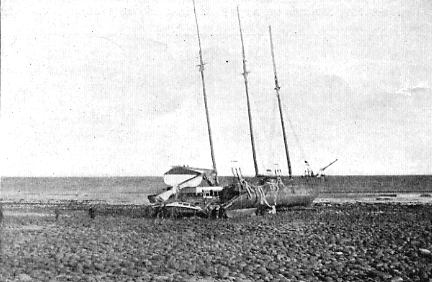By Mike Bisceglia
Hampton Union, Tuesday, April 18, 2006
[The following article is courtesy of the Hampton Union and Seacoast Online.]

The Glendon took its proud maiden voyage from Kennebunk, Maine, in 1880. It was a large, three-masted schooner and boasted a strong crew of seven. The ship was designed and rigged for heavy loads, and in February 1896 it was laden with 460 tons of coal for destinations in northern New England. It never completed its journey.
Keep in mind that 1896 was long before the time when weather bulletins could be issued by the National Weather Service, Doppler radar or enhanced ship-to-shore communication. Simply, it was an era when men (sorry, no women on board at this time), braved rough seas on mighty ships. The Glendon and its crew, however, were no match for a powerful nor’easter, which doomed the ship off the coast of Hampton.
It was mid-afternoon Sunday, Feb. 9, 1896, and the gray skies suddenly turned heavy and foreboding. The wind grew to a gale, bringing with it driving snow. Two schooners worked their way along the coast. One dropped anchor along Salisbury Beach, Mass.; the other, the Glendon, continued on its coastal trek.
It didn’t last long in those turbulent waters.
By 5:30, crew members were trying to save their lives by hanging from the rigging of ship as it drifted toward the rocks near Cutler’s Sea View House.
In short order, the Glendon smashed into the rocks, sending tons of coal into the sea.
Word was sent to the life-saving station at Straw’s Point.
Soon, help was on the way, but the ferocious storm thwarted efforts to save the crew with the use of a gun firing a line to the stranded men.
Time and again, the gun was reloaded and fired. Night fell, but the rescuers did not give up hope. They built a huge bonfire, so crew members only a few hundred yards off shore could see they were not abandoned.
Cries for help could be heard over the ocean’s roar. Around 7 o’clock, the line found the rigging. One by one, Glendon crew members found their way to it and safety.
Within a few weeks, approximately 200 tons of coal was salvaged from the Glendon. Later, a portion of the hull was made into a restaurant, which sold chowder and saltwater taffy.
In 1938, veteran fisherman Albert Dunbrack was tending his lobster traps and found the Glendon’s anchor and chain.
Mr. Cutler, owner of the Sea View House, never wanted to see another disaster such as the wreck of the Glendon.
It was through his tireless efforts that a Coast Guard station became a reality at North Beach in Hampton.
The coal in the hold of the Glendon was sold to be salvaged to Capt. Frank Nudd, who lost his life in the Fourth of July tornado of 1898, but that’s another story.
For more information on The Glendon and life in early Hampton, visit with the good folks at the Hampton Historical Society and the Lane Memorial Library. Mike Bisceglia is a former school teacher and a Hampton resident.